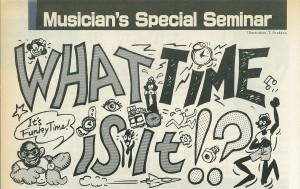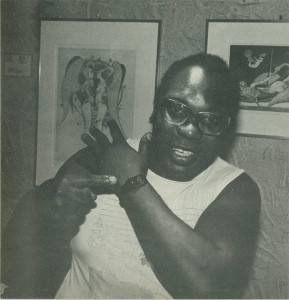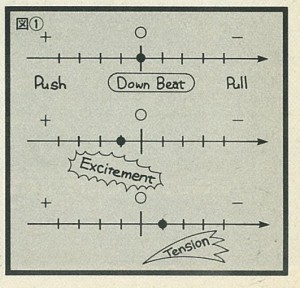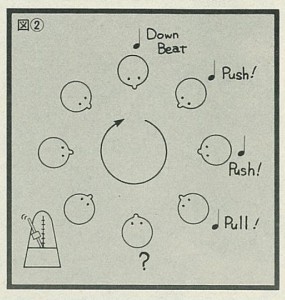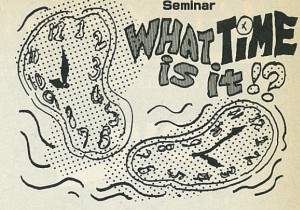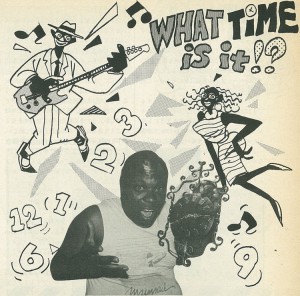From August, 1986 issue of Bass Magazine
Translation of Musician’s Special Seminar
What Time Is it!? By Paul Jackson
Series No.1: PUT THE FEELING IN YOUR BASS LINE!
Japanese bands are wonderful, but they need to strengthen their bass lines.
Hello, this is Paul Jackson. I plan to talk about rhythm on this magazine for the next year, in four issues, so, thanks in advance staying with me till the end.
The first thing I felt since I moved to Japan, and after playing with Japanese musicians is that Japanese bands are weak in the rhythm section. The rhythm section (a drummer and a bass player) create rhythm by playing together and can add “feel” to the music. In this rhythm section, the bassist has a very important role, as he has a lot of control over the feel of the song. Japanese bands, however, are not good at this. To improve it, it will be my pleasure if my experience and knowledge are made use of, and this is why I wanted to write this series for Bass magazine. The Musical sense which Japanese musicians have is wonderful, and I think this will become an important part of the global music scene.
Before coming into the main body of my series, I want to explain the themes of each of the four articles in the series. The theme this time is PUT THE FEELING IN YOUR BASS LINE. Here, you learn how to polish your expression of your emotions and feelings in your bass lines. It is not about techniques only, nor is it about only playing your bass emotionally. It’s more about how to create your bass lines like waves. Practically, it is about sharpening your sense of rhythm, so you play with a sense of push and pull distinctly. Push and pull are very important techniques to richly express your feelings in your bass lines.
The second in the series is HOW TO TRAIN YOUR DRUMMER. This is because a drummer and a bass player always have to play together and their relationship is tight. I will talk about effective ways for a bassist to practice with a drummer.
The third article is what I call REPEAT! REPEAT! Bassists play many technically complicated lines, but I have found they never play exactly the same lines. In this lesson, I want to train you so that you can play the same lines over and over, to the level of groove, also utilizing what I teach in the first lesson.
The fourth in this series is WHAT TIME IS IT? Here you get to learn to feel space between rhythms.
Three Key Words, Push, Pull and Down Beat
Now, let’s get into the main subject.
I want to start with this question; “What do you feel when you play bass?
Anybody can play the bass if the bass line is simple, but it must express some feelings. The same bass line can be played in different ways. It can be played straight forward, or with emotions. The bass line can control the whole song.
It therefore becomes necessary to play In and Out clearly and differently, so that your bass line can be expressive enough. “In” here means the “Down Beat”, or the middle of a rhythm. “Out” means slightly off the middle of a rhythm, Push and Pull. Note: the “Down Beat” can refer to the first beat of a measure, but in this case I mean playing exactly on the beat no matter what beat of the measure it is.
The concepts of Down Beat, Push and Pull are like this;
Please look at the Table 1. Consider this as visualization of one moment cut out from the flow of rhythm. The horizontal axial is flow of time – going towards the direction of an arrow. 0 is the center of rhythm. The Down Beat is when you make sound exactly on this point. + is the Push side, – is the Pull side. Scales are there, just to show there are many Pushes and Pulls and they don’t have to be so exact.
A bassist can create excitement by playing on Push side. On the contrary, when he plays on Pull side, it is like holding energy, so it can create Tension. It’s like pulling a rubber band.
Push and Pull are both something to heighten the energy a bass line has. These are two different types of energy. By bringing these into bass lines, you can strengthen or weaken energy of music and can control many things.
In order to control Push and Pull well, you must train to grasp the center of rhythm. Most bass players speed up when doing Push, and slow down when doing Pull. In order to be balanced, you must be well aware of the central position. This can be achieved when a drummer and a bass player train and think in the same way.
For instance, when a bassist plays with Pull, a drummer needs to maintain the center, without slowing down. This way, a bassist makes good Pull against a drummer. Tension is born at this time (you’ll know this when you listen to good blues), but a bassist must always be aware of the center of rhythm.
It is very easy for a drummer to Push, because being a drummer, the more excited he is, the more at Push he plays. When this happens, a bassist should perhaps Pull to maintain good balance.
As I have explained so far, Beat is something like rubber band, which you can pull at one end, or can be pulled at both ends. That way, you create different rhythms, and unique feelings.
To sum it up, both a drummer and a bass player must know the location of Down Beat. Only after knowing this, they can play good Push and Pull, and can express many different feelings.
I want to point out here that this is to change “your way of thinking”. It is not enough that you just play. At times, you must create philosophy and concepts through your playing. Alternatively, your concepts can change your music. Please remember this.
Here is an exercise to play differently for Push, Pull and Down Beat
I will introduce practical exercises, here, so that you can play Push, Pull and Down Beat differently.
Exercise 1: Set a metronome to 120 and play with it, playing quarter notes for one bar. Play with Down Beat. Then, during the next bar, play just a little Push, ahead of the metronome and understand the jumping feeling, the anticipation. In the next bar, play Down Beat again. This way, you continue alternating playing Down Beat and Push. Each time, be aware how much you can play Push, and how exactly you can come back to the center of rhythm. As you get used to this, try to do as big Push as possible. When you become good at this, change a tempo of a metronome to 8th notes and practice Push and Down Beat in the same way.
The purpose of this exercise is, without slowing down or speeding up, you become able to control Push and Pull, and to come back to center of rhythm however much you do Push and Pull. It is a simple exercise, but you can learn to control bass lines. The rest is what kind of variations you practice.
Exercise 2: This is an exercise to play the first note in a bar Down Beat, and play the rest of the 3 notes as Push or Pull. Exercise 3 is the same thing, but play 2 bars. Here you play only the first note Down Beat and the other 7 beats with Push or Pull.
If you are at an intermediate or advanced level, do these exercises using your bass line. I recommend you practice with your drummer as much as possible. As an example of practicing a bass line, I will insert here Exercise 4. Now, do you think your bass line has become expressive?
My God! Only Two out of Eight Can Play Down Beat!
Now I will talk about a rhythm training which I taught at a certain bass clinic in February, this year (1986).
First, several bassists take a seat in circle as shown in Fig.2. Listening to a a metronome, they take turn in playing just one quarter note each. As each player’s sense of rhythm is not the same, rhythm keeps on changing. One bassist might be late, which might be made up for by still another. Alternatively, I had a metronome stopped, and had them play just depending on their own rhythm sense. What’s interesting is that if the first player plays Down Beat, when it becomes his turn again after the whole circles goes round, it is always Down Beat. As a result, a bassist can realize if he is on Push side, or on Pull side. The last time when I trained them, 3 out of 8 students were on Push, 3 others on Pull and the other two played Down Beat.
By doing this exercise, students got to listen to each sound more carefully and improved. It is important to be aware of your own sense of rhythm. This is interesting, so I suggest you try, but maybe it might be difficult for 8 to 9 bass players to get together at one same place. Then, it can be among smaller number of bassist, like 3 or 5, but if possible, the number of people had better be an odd number, so that the head of each bar can come to a different person, as rotation goes.
Try Grasping Push and Pull Sense by Listening to a CD.
Roughly speaking, bassists can be divided into Push and Pull types. Rock, Fusion and Latin Music are mostly Push. To name bassists, Jaco Pastorius and Stanley Clarke are both Push. Reggae, Blues, Ballad and Big Band are all Pull. Big Bands usually play either Pull or Down Beat. By doing so, they can lift up whole song. I suggest you listen to these different types of music to learn how to play Push and Pull.
I am Push, myself, but I play differently, depending on music. For your reference, here are some songs I played.
First, “Sly” in the Headhunters by Herbie Hancock. This is a good example of Push. “Watermelon Man” is a good example of Pull. Vein Melters is rather strong Pull. “Actual Proof” in the album “Thrust” is Push, and “Butterfly” is a good example of both Push and Pull. “Hang Up Your Hang Ups” and “Steppin’ It” in “Man Child” are both Push.
The session this time is over now. The theme for the next session will be HOW TO TRAIN YOUR DRUMMER. I suggest you to find your favorite drummer by then. For myself, I have been lucky enough to have Mike Clark, with whom I have been able to practice for about 4 years. This is the best way to improve rhythm section. Well, see you again.



